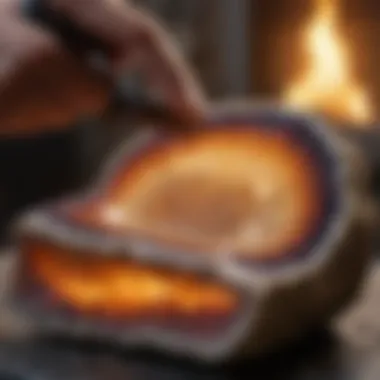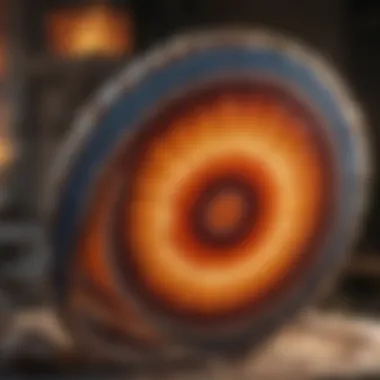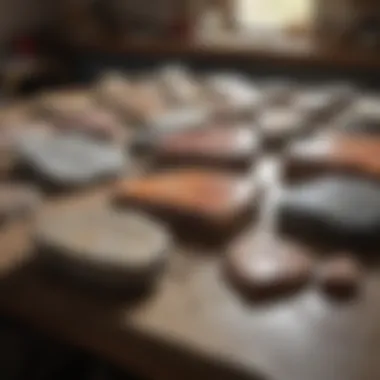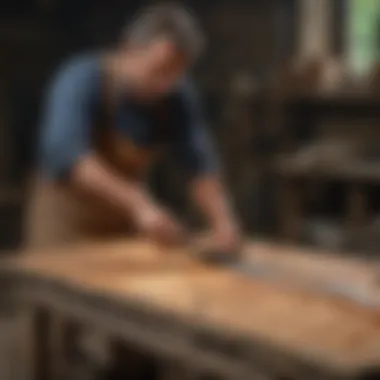Mastering the Art of Rock Slab Saws: A Comprehensive Enthusiast's Guide


Rock and Fossil Identification
Rock and fossil identification is a crucial aspect of delving into the realm of rock slab saws. Understanding the types of rocks and fossils is fundamental to recognizing the raw material you will be working with. Various rocks such as sedimentary, igneous, and metamorphic carry distinct characteristics that can be identified through color, texture, and structure. Fossils add another layer of interest, with imprints of ancient life forms preserved in rocks. Tools such as magnifiers, hardness picks, and geology hammers aid in the identification process, allowing enthusiasts to pinpoint specific features.
Collecting Tips and Techniques
Moving beyond identification, collecting rocks and fossils necessitates adherence to best practices. Whether combing through a riverbed or exploring mountainsides, knowing where to look is key. Prime collecting sites often boast a variety of specimens waiting to be discovered. Safety is paramount when extracting specimens, requiring tools like chisels and brushes to carefully remove rocks without causing damage. By incorporating techniques for proper extraction, collectors can ensure the integrity of their findings.
Preservation and Display
Preserving collected rocks and fossils is essential to maintaining their integrity for years to come. Techniques such as cleaning with soft brushes and mild detergents help remove dirt without harming delicate structures. Once cleaned, proper storage methods, including using acid-free paper and specialized boxes, safeguard specimens from environmental damage. Creative display ideas allow enthusiasts to showcase their treasures, whether through custom-made stands or incorporation into decorative pieces, merging functionality with aesthetic appeal.
Geological Insights
Delving into the geological aspects of rocks and fossils provides a deeper understanding of their origins and significance. Geological formations showcase the processes that shaped rocks over millennia, unveiling the Earth's complex history. The historical significance of particular rocks and fossils sheds light on past ecosystems and evolutionary timelines. Notable discoveries in the field continue to expand our knowledge, uncovering rare specimens or fossils that rewrite scientific understandings, exemplifying the endless fascination within the world of rock slab saws.
Introduction to Rock Slab Saws
In the realm of lapidary arts, rock slab saws stand as essential tools that form the backbone of rock cutting and shaping processes. This section serves as a gateway into the intricate world of rock slab saws, offering enthusiasts a glimpse into the foundation of this craft. Understanding rock slab saws is akin to unraveling the first chapter of a captivating story, where the potential to transform raw materials into exquisite pieces of art begins.
What are Rock Slab Saws?
Rock slab saws are precision instruments designed to slice through rough rock material with unparalleled accuracy. These saws come in various shapes and sizes, each tailored to cater to different cutting needs within the realm of lapidary arts. From small tabletop versions to large industrial-sized machinery, rock slab saws serve as the starting point for artisans and enthusiasts to shape rocks into desired forms.
Importance of Rock Slab Saws in Lapidary
The significance of rock slab saws in the world of lapidary cannot be overstated. These tools represent the fundamental step in turning raw, unassuming rocks into stunning display pieces. Without rock slab saws, the precision and efficiency required to cut through tough materials like agate, jasper, and obsidian would be near impossible to achieve. They act as the catalyst that propels the lapidary process forward, paving the way for intricate craftsmanship and artistic expression.
Evolution of Rock Slab Saws
The evolution of rock slab saws mirrors the progression of lapidary arts throughout history. From rudimentary hand-operated devices to advanced automated systems, the journey of rock slab saws showcases human ingenuity and technological advancements. Innovations in blade design, motor efficiency, and cutting techniques have transformed rock slab saws into highly specialized tools that cater to the diverse needs of modern rock and fossil collectors.
Types of Rock Slab Saws


In the realm of rock slab cutting, understanding the various types of cutting tools plays a pivotal role in achieving precision and efficiency. This section delves deep into the significance of different rock slab saws and their specific applications within the lapidary world. By exploring the nuances of each type, enthusiasts can grasp the nuances that guide their choice of machinery for cutting and shaping rock slabs.
Trim Saws
Within the array of rock slab saws, trim saws stand out as essential tools designed for preliminary cutting and shaping tasks. These saws are characterized by their compact size and high-speed capabilities, allowing for precise cuts on smaller rocks and mineral specimens. Enthusiasts often rely on trim saws to cut rough slabs into manageable sizes before proceeding to further shaping and refining processes.
Slab Saws
Slab saws represent a cornerstone in the world of rock slab cutting, catering to the cutting of large, flat rocks with efficiency and accuracy. These robust machines are equipped with diamond blades that effortlessly slice through thick slabs of stone, making them ideal for processing larger specimens with ease. By harnessing the power of slab saws, lapidary enthusiasts can transform hefty rocks into sleek, polished slabs ready for the next stages of lapidary work.
Band Saws
Band saws emerge as versatile tools in the realm of rock slab cutting, known for their flexibility in cutting intricate shapes and curves in various rock materials. Unlike traditional slab saws, band saws feature a continuous loop of toothed metal that enables precise and intricate cuts, making them favored tools for lapidaries seeking creativity in their rock slab designs. With their maneuverability and cutting accuracy, band saws empower enthusiasts to explore intricate cutting patterns and designs with finesse.
Covington Saws
Covington saws stand out as a reliable choice for lapidary enthusiasts seeking durability and precision in their rock cutting endeavors. These specialized saws are crafted to deliver consistent and accurate cuts while maintaining a user-friendly design that caters to both beginners and seasoned professionals. With Covington saws, enthusiasts can tackle a wide range of cutting tasks efficiently, ensuring consistent results in their rock slab projects.
Key Components of Rock Slab Saws
Rock slab saws are intricate machines that require various components to function efficiently. Understanding the key components of rock slab saws is crucial for enthusiasts looking to delve into the world of lapidary. Each component plays a vital role in the cutting and shaping process, contributing to the overall performance and precision of the saw.
Blades and Diamond Disks
Blades and diamond disks are the cutting elements of rock slab saws, essential for slicing through tough rock material with accuracy and smoothness. High-quality blades and diamond disks are paramount in achieving precise cuts and minimizing wastage. It is important to select the appropriate blade or disk based on the type of material being cut to ensure optimal results. The quality, size, and type of blade or disk significantly impact the finished product, making them one of the most critical components of a rock slab saw.
Motor and Power System
The motor and power system are the powerhouse of a rock slab saw, providing the necessary energy to drive the blades or diamond disks. The efficiency and power of the motor directly impact the cutting speed and effectiveness of the saw. Enthusiasts should consider the motor's horsepower, speed variability, and durability when selecting a rock slab saw. A robust motor ensures smooth operation and consistent cutting performance, enhancing the user experience and overall productivity.
Feed Systems
Feed systems regulate the rate at which the rock slab moves through the saw, controlling the cutting pace and depth. Various feed systems, such as gravity-fed and automatic feed, cater to different cutting requirements and user preferences. The choice of feed system influences cutting precision, material wastage, and overall efficiency. Enthusiasts must understand the functionality of different feed systems to select the one that aligns with their cutting goals and desired outcomes.
Cooling Systems


Cooling systems are integral to preventing overheating and maintaining blade or disk integrity during the cutting process. Water-based cooling systems or oil bath systems help dissipate heat generated from friction, ensuring prolonged blade or disk lifespan and sustained cutting quality. Adequate cooling not only enhances cutting precision but also safeguards the saw from potential damage due to excessive heat. Enthusiasts should prioritize efficient cooling systems to optimize cutting performance and prolong the longevity of their rock slab saw.
Choosing the Right Rock Slab Saw
In the realm of rock slab cutting, selecting the appropriate rock slab saw is a crucial decision that can significantly impact the quality and precision of your work. This section delves into the essential factors that enthusiasts need to consider when choosing the right rock slab saw for their cutting endeavors. From the type of saw to specific features, each aspect plays a vital role in the ultimate outcome of the cutting process.
Factors to Consider
When evaluating which rock slab saw to invest in, several key factors should be taken into account. Firstly, the type of cutting projects you intend to undertake is paramount. Different saws are designed for various cutting tasks, whether you aim for precision trimming or large-scale slab cutting. Understanding your specific cutting needs will guide you in selecting a saw that aligns with your goals and expectations.
Budget and Affordability
While rock slab saws come in a wide range of prices, it is essential to strike a balance between quality and affordability. Investing in a high-quality saw may initially seem costly, but it often pays off in terms of durability, performance, and ease of use. Consider your budget constraints alongside the quality and features you require to ensure a long-term investment that meets your cutting requirements efficiently.
Size and Portability
The size and portability of a rock slab saw are critical considerations, particularly for enthusiasts with limited workshop space or a need for transportation. Compact saws are ideal for small workspaces, offering convenience without compromising cutting capacity. Conversely, larger saws cater to those handling sizable rocks but may require ample space. Assess your workspace and mobility needs to determine the most suitable size and portability features for your saw.
Blade Compatibility and Versatility
The compatibility of blades with your chosen rock slab saw is pivotal for achieving precise and efficient cuts. Different saws accommodate various blade types and sizes, each tailored to specific cutting techniques and materials. Opt for a saw with versatile blade compatibility to expand your cutting capabilities and handle a diverse range of rock types. Versatility in blade options allows for creative experimentation and ensures optimal performance across various cutting applications.
Safety Precautions and Best Practices
Safety precautions and adhering to best practices are crucial elements in the realm of rock slab cutting, ensuring the safety of both individuals and the longevity of equipment. In the context of exploring rock slab saws, understanding and implementing these measures can make a significant difference in the efficiency and outcome of the cutting process. By prioritizing safety precautions and best practices, enthusiasts can mitigate risks, maintain a conducive working environment, and enhance overall productivity in their lapidary endeavors.
Protective Gear
Protective gear plays a fundamental role in safeguarding individuals from potential hazards associated with rock slab cutting. When operating rock slab saws, enthusiasts should invest in high-quality safety equipment such as goggles, gloves, ear protection, and sturdy footwear. These gears act as a shield against flying debris, sharp edges, noise levels, and accidental slips, reducing the likelihood of injuries during the cutting process. Moreover, utilizing proper protective gear not only ensures personal safety but also promotes a professional approach to lapidary work, instilling a sense of discipline and responsibility in enthusiasts.
Safety Guidelines
Adhering to strict safety guidelines is imperative in the realm of rock slab cutting to prevent accidents and ensure a secure working environment. Enthusiasts should familiarize themselves with the operating manual of the rock slab saw, understanding essential safety instructions and protocols outlined by the manufacturer. Following guidelines related to machine usage, material handling, and emergency procedures is paramount in mitigating risks and maintaining a safe workspace. By enforcing safety guidelines effectively, enthusiasts cultivate a culture of awareness and cautiousness, promoting a harmonious and secure environment for rock slab cutting activities.
Maintenance and Inspection


Regular maintenance and thorough inspection of rock slab saws are essential practices that uphold machine performance and longevity. Enthusiasts should adhere to maintenance schedules provided by manufacturers, conducting routine checks on blades, motors, cooling systems, and overall machine operation. Inspecting for wear and tear, loose components, or irregularities ensures that the saw operates optimally and reduces the likelihood of malfunctions during cutting tasks. By investing time in proper maintenance and diligent inspection, enthusiasts prolong the lifespan of their equipment, enhance cutting precision, and uphold safety standards in their lapidary pursuits.
Advanced Techniques and Tips
In the realm of rock slab saws, mastering advanced techniques and tips is paramount for enthusiasts looking to elevate their craftsmanship. This section delves into invaluable strategies that can take your rock cutting and shaping skills to the next level. Advanced techniques encompass a range of methods that go beyond basic cutting, providing precision and finesse in creating intricate designs and patterns. By understanding and implementing these techniques effectively, enthusiasts can unlock a world of possibilities in their lapidary pursuits.
Precision Cutting
Precision cutting is an art form that requires patience, skill, and attention to detail. This technique involves cutting rock slabs with ultimate accuracy, ensuring clean edges and seamless shapes. Utilizing specialized tools and equipment, such as diamond blades and precise saw settings, is crucial for achieving the desired results. Enthusiasts can enhance their precision cutting skills through practice, experimentation, and a deep understanding of the materials they are working with. By prioritizing precision cutting techniques, enthusiasts can elevate the quality of their final creations and showcase impeccable craftsmanship.
Grinding and Polishing
Grinding and polishing are essential steps in the rock slab cutting process, adding refinement and luster to the final pieces. After rough cutting the slabs, grinding helps smooth out rough edges and imperfections, while polishing brings out the natural beauty and colors of the rocks. Understanding the proper grinding and polishing techniques is vital to achieving professional-grade results. Enthusiasts must select the right abrasives, compounds, and tools for each type of rock to achieve the desired finish. By mastering the art of grinding and polishing, enthusiasts can transform ordinary rock slabs into stunning display pieces that shine with brilliance.
Pattern Cutting
Pattern cutting introduces a creative element to rock slab sawing, allowing enthusiasts to experiment with intricate designs and shapes. This technique involves cutting rocks in specific patterns to create unique visual effects and textures. From simple geometric patterns to elaborate motifs, pattern cutting adds a dynamic dimension to lapidary artwork. Enthusiasts can let their creativity soar by exploring different cutting patterns and combinations, giving each piece a distinctive and captivating appeal. By incorporating pattern cutting into their repertoire, enthusiasts can infuse personality and style into their rock slab creations, making them truly one-of-a-kind.
Troubleshooting Common Issues
Even the most skilled enthusiasts may encounter challenges while working with rock slab saws. Troubleshooting common issues is an essential skill that helps address problems such as blade wear, misalignment, or material mishaps. By understanding common issues and their solutions, enthusiasts can overcome obstacles efficiently and ensure smooth workflow. Learning how to troubleshoot common problems empowers enthusiasts to work with confidence, tackle unforeseen issues, and maintain the integrity of their equipment. By honing their troubleshooting skills, enthusiasts can navigate the intricacies of rock slab cutting with ease and precision.
Conclusion
In concluding our comprehensive guide on the world of rock slab saws, it is evident that delving into this realm offers enthusiasts a captivating journey of skill and precision. The depth of knowledge acquired is invaluable, laying the groundwork for mastering the art of rock cutting and shaping with finesse. Throughout this article, we have highlighted the evolution, importance, types, key components, selection process, safety precautions, advanced techniques, and now we come full circle to embrace the essence of rock slab cutting.
The significance of this conclusion lies in reinforcing the essence of craftsmanship and the fusion of artistry with technical proficiency. By embracing the intricacies of rock slab cutting, enthusiasts not only hone their skills but also cultivate a deep appreciation for the geological wonders they work with. Through each cut, polish, and finish, a piece of raw rock transforms into a masterpiece, reflecting the dedication and expertise of the cutter.
Exploring advanced techniques such as precision cutting, grinding, polishing, and troubleshooting common issues enriches the enthusiast's toolkit, enabling them to overcome challenges with agility and finesse. The journey of rock slab cutting extends beyond mere craftsmanship; it is a testament to patience, perseverance, and a deep connection with Earth's geological marvels.
In essence, the conclusion encapsulates the culmination of knowledge, skill, and passion required to excel in the realm of rock slab cutting. It serves as a reminder that every cut is a step towards mastery, every challenge a lesson in craftsmanship, and every finished piece a testament to the dedication of the enthusiast.
Embracing the Art of Rock Slab Cutting
Embracing the art of rock slab cutting goes beyond the mere act of shaping stones; it symbolizes a deep connection to Earth's geological heritage and a profound appreciation for the beauty found within the rough exterior of a rock slab. As enthusiasts delve into this intricate art form, they unlock a world of creativity, precision, and patience that sets the foundation for mastering the craft.
The process of cutting rock slabs requires more than just technical skill; it demands an artistic eye to envision the potential within each raw piece of rock. From selecting the right slab saw to intricately understanding the properties of different rocks, embracing this art form necessitates a blend of scientific knowledge and creative intuition.
As enthusiasts navigate through the realms of precision cutting, grinding, and polishing, they embark on a journey of transformation where rough, unassuming rocks evolve into elegant masterpieces. Each step in the cutting process unveils layers of beauty hidden within the rock, showcasing the intricate patterns, colors, and textures that make every slab unique.
Through embracing the art of rock slab cutting, enthusiasts not only refine their technical skills but also foster a deep connection to the Earth's natural wonders. Every finished piece tells a story of patience, dedication, and the harmonious relationship between human ingenuity and nature's artistry. It is in this union of craftsmanship and reverent appreciation for Earth's bounties that the true essence of rock slab cutting is realized.







